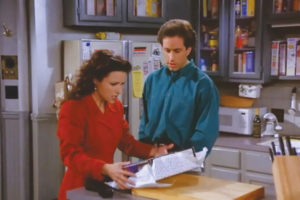Gift Giving 101
It really is better to give than to receive
When I was growing up in the cornfields of the Midwest, one of my favorite “life lessons” was that “little boys were put on Earth to give little girls presents.” This ideal was later embellished by a great friend of mine who was (and still is) an expert in all things correct – she counseled me that husbands should give their wives only gifts that fit into an envelope. Car keys, diamonds, plane tickets, cash, deeds to vacation homes … you get the picture. Although initially skeptical, after I received yet another Valentine’s gift purchased at 7:45 p.m. from the clearance section at Home Depot, I realized my friend was really smart.
What, I wondered, would drive gift-giving choices if the giver was not motivated by the is-Christmas-really-tomorrow panic? What does the giver realize in the gifting scenario? Is the giving of gifts simply a social dictate by which we are all ruled?
Apparently I’m not the first person to ask this question. A group of doctors with some extra time on their hands and a functional MRI machine (fMRI) decided to explore the gifting phenomenon. As reported, appropriately on Valentine’s Day 2015, in Central California Life Magazine, it’s actually the giver who receives the most benefit from the exchange. The fMRI results showed that the act of gift giving activates the reward centers in our brains. This is the same part of the brain that reacts to everything rewarding, from a great bottle of Chardonnay to winning the Powerball. Theory exists then that if one were to give enough gifts, or the right gifts, one would experience a “gift-giver’s high”! Is this, in itself, the motivating factor to being a rewarding giver?
O. Henry’s “Gift of the Magi” is to gift giving what Dear Abby is to heartbreaks – the thesis by which generations have measured their actions. In the story, the writer shined a light on the quality versus quantity debate by valuing the thought, not the expense, of the exchange. As Della and Jim sacrificed to give gifts to each other, they were demonstrating altruism at its finest; and, not surprisingly, altruistic acts also activate the reward centers in our brains. Both Della and Jim experienced more joy in the giving of their gifts than in the receiving of what ended up being completely useless presents.
JUST WHO IS THIS GIFT FOR?
Shankar Vedantam, NPR’s social science correspondent and host of the Hidden Brain podcasts, explored the whole gift-giving scenario by taking a serious look at the science behind choosing a wedding gift. With the advent of the “registry,” the theory behind wedding gifts should be a no-brainer – brides and grooms go to the store and declare “I want this,” then friends and family go and buy it. They are transparently explicit in their desires and there need be very little thought on the part of the giver – simply follow the list and done. Right?
Wrong. According to Vedantam, the closer the giver is to the couple, the less likely they are to purchase from the registry, thereby circumventing the ease of the gift-giving scenario by complicating it with ulterior motive. It’s a little like “marking their territory,” intimating their close relationship to the bride and that they know what the recipients want, more so than the recipients themselves know. Subconsciously the giver is telling the recipients that they are so close that they are exempt from following the list of gifts because, well, they’re really close. It’s inverse logic like this that creates bridezillas!
When picking a gift, especially off-list, how does the giver choose what to give? Dan Pink from the Hidden Brain’s Stopwatch Science segment looked at the trends in giving gifts and discovered that givers tend to lean toward what they themselves deem to be impressive and desirable. Receivers, on the other hand, are more likely to trade off desirability for feasibility. For instance, the giver might think a gift certificate to Ruth’s Chris is a fabulous idea. The receivers, however, see it as needing to pay for a babysitter for a minimum of three hours. Impressive, yes! Desirable, not quite.
THE INFLUENCE OF SEINFELD AND CREW
 Which brings us to re-gifting. With the increasing propensity toward giving off-list gifts, what started out as a joke on a Seinfeld episode has turned into an acceptable (in some circles) social norm. The stigma of the “re-gift” is not nearly as ostracizing anymore as one would think. Pink reports on research showing that the original givers are often not offended by having their gift forwarded, particularly if the re-gift is store-bought. As the sentimentality of the gift increases, however, the acceptance of re-gifting decreases. You cannot re-gift the afghan your Aunt Susie knitted for you, but you can re-gift the aquarium filter your brother got you – especially if you don’t have an aquarium!
Which brings us to re-gifting. With the increasing propensity toward giving off-list gifts, what started out as a joke on a Seinfeld episode has turned into an acceptable (in some circles) social norm. The stigma of the “re-gift” is not nearly as ostracizing anymore as one would think. Pink reports on research showing that the original givers are often not offended by having their gift forwarded, particularly if the re-gift is store-bought. As the sentimentality of the gift increases, however, the acceptance of re-gifting decreases. You cannot re-gift the afghan your Aunt Susie knitted for you, but you can re-gift the aquarium filter your brother got you – especially if you don’t have an aquarium!
After all the research is done and the findings analyzed, all givers need to keep in mind that it isn’t about finding the perfect gift, or sticking to a list. It isn’t about the wrapping paper or the price tag. It’s about the fact that you are doing life together as family and friends. That is the greatest gift of all.


